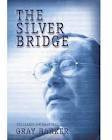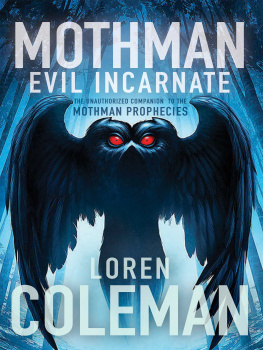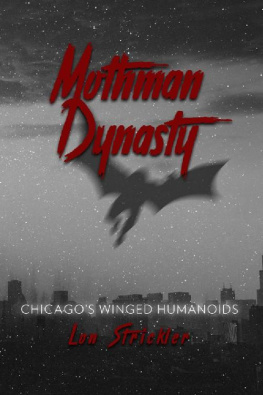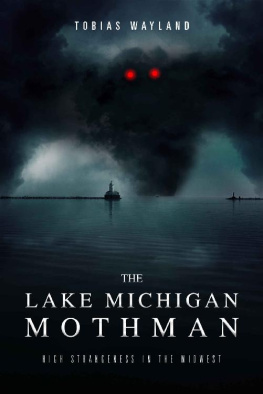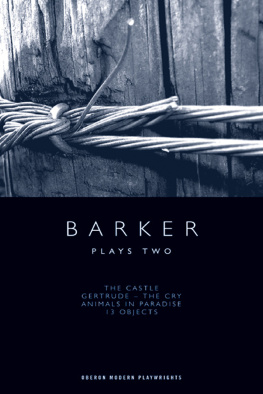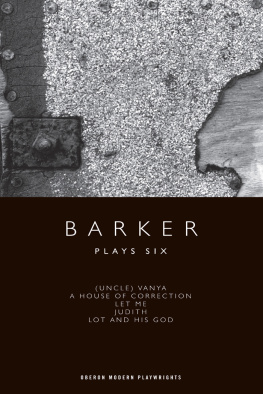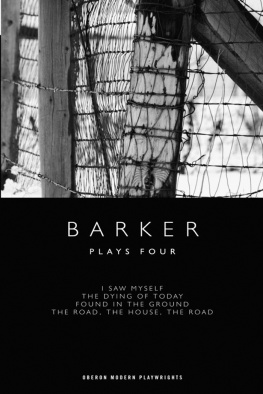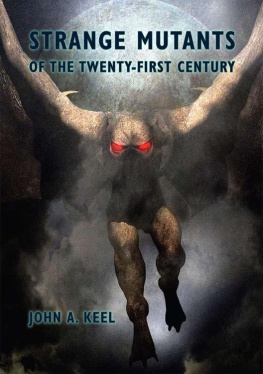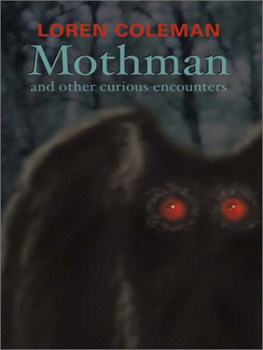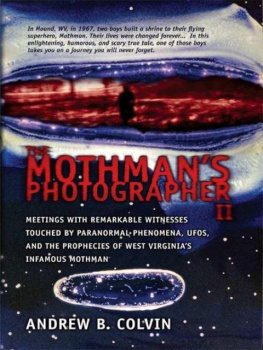
FOREWORD TO THE 2008 EDITION
I came across Gray Barkers Silver Bridge during a flurry of synchronicities in the early 1990s that also caused me to read John Keels book The Mothman Prophecies: An Investigation Into the Mysterious American Visits of the Infamous Feathery Garuda. I waited many weeks for one of the few remaining copies of Silver Bridge to be delivered to my local library. I was intensely interested in Grays take because I was one of those original witnesses Keel and Barker were going around trying to interview in the late 1960s. I happened to grow up in Mound, WV (now N. Charleston), and was 7 years old when the Birdman - later called Mothman - was first spotted. While Mothman became famous for his visits to Pt. Pleasant, he also buzzed Charlestons State Capitol dome, Sunrise Museum, and Union Carbide plant - where I glimpsed him. Later, in 1973, I saw what seemed to be a shadowy echo of Mothman emerge from a tree. The location was right where one of my best friends had seen a vision - in 1967 - about an attack on NYC in 2001 that would start WWIII. According to my friend, the Birdman had suggested we build a shrine and stand in a certain spot in order to see the future. I was dubious, of course, but my friend soon proved his case by daring me to stand in a spot near his front door. When I accepted the dare, I indeed saw brief, flickering images of the same vision. As one might expect, I was shocked and horrified. My pal later moved away, but I never forgot the incident.
As a witness, I was chilled to the bone when I read Keels weird, scary Mothman tale, for I then knew that the memories I had of odd childhood events were accurate. However The Silver Bridge was just as chilling for me, because Barker often utilized the point of view of a young boy, longing to know Mothman. And that was me! Even today, The Silver Bridge takes me back to my experiences in a very real way. Ironically, the chapters many consider to be hokey or contrived - like where Barker asks us to see things from Mothmans point of view - are the ones that affect me the most. In many ways, I am still that Mothboy, searching for hope, dreaming of flying. Grays understanding of the inner states of witnesses was uncanny. Its as if Barker came into contact with this phenomenon himself He knew. He understood its human quotient. Many researchers toil for decades without realizing that our collective unconscious may be involved. Barker grasped this possibility instantly, and expounded upon it in an elegant, nuanced way.
While it is true that Keel, myself, and others sense that Mothman may actually be the Garuda, an archetypal, crime-fighting birdman sending psychic messages to humans in order to stop global catastrophe, that doesnt paint the whole picture. The birdman also sends us key, intimate messages about our personal lives. It is within this private realm that Gray, ever human and caring, timelessly shines.
Andy Colvin
INTRODUCTION TO THE 2008 EDITION
I first met Gray Barker at the 2nd National UFO Conference in Cleveland, Ohio in 1965. The year before, at the first meeting of that long-running annual event (which I co-founded with Rick Hilberg and the late Al Manak), Jim Moseley had said, Weve got to get Gray to come to one of these things. Gray was indeed an honored guest from then on, and it was to Jim Moseley that the first Gray Barker Lifetime Achievement in Ufology Award was eventually given, in Atlanta in 1995.
By then Gray had long passed from these shores, leaving us with an extraordinary legacy of wild rumor, exotic folklore, poetic license, and mysterious fact - puzzle pieces of what was (and still is) ufology.
Gray got his one and only best-selling book early in his career, after being a member of the first UFO club, Albert K. Benders International Flying Saucer Bureau. Gray was starting his own long-running Saucerian Bulletin and publishing house (Saucerian Publications) when Bender was mysteriously forced out of ufology - he said - by three men in dark clothing, supposedly government agents. Eventually, the story morphed into these visitors being ufonauts. We now know, of course, that in 1952 the CIA had recommended that a certain amount of mischief be introduced into private UFO societies following the wave of UFOs over Washington, D.C., which had compromised national security (or so it was said at the time). The story might have died with a very frightened and silenced Bender were it not for Grays explosive and entertaining book about the Bender case, They Knew Too Much About the Flying Saucers.
Of course, the Men in Black did not start with Bender, or Barker. As early as 1947, Seattles famous Maury Island case involved such mysterious visitors, and the Man in Black repeatedly shows up in medieval occult lore - often, as the devil himself! But Barkers exposition of the Men in Black put them on the ufology radar and into popular imagination, where they have remained to the present day.
Gray Barker was born in Rifle, Virginia, in 1925, but is best known for his many years in Clarksburg, West Virginia, where he became the first investigator on the scene of the famous Flatwoods Monster and Mothman cases. A college graduate majoring in English, Barker had a flare for extracting the folklore from UFO lore, and the UFO lore from the rich folkloric tradition indigenous to the Appalachian Mountains. Being a local film distributor for many years, he also had an intimate knowledge of the people of Appalachia who, because of their long-standing need to survive in the face of incredible hardships, tend to exhibit an unusual mix of sarcasm, superstition, honesty, dry (and often black) humor, practicality, naivete, and dramatic theatricality. In essence, they can be yarn spinners and straight-shooters rolled into one. Gray incorporated all of these tendencies into his work, often causing it to be misunderstood by both supporters and detractors from the big city.
I met Gray in his middle period after Flatwoods and Bender, but before the Mothman scare that led to the volume presently under consideration. One time we were having a dinner meeting in an Atlanta restaurant, with Moseley and local fans. Someone brought up the question of what Barker really believes. I looked at Gray, slyly.
I think I know. I said, smiling. On one level, Gray is the staunchest believer in some of the most bizarre stuff in ufology. He is the Champion of The Weird. But, I continued, that isnt the real story. Under that is Gray the cynic, who believes none of it - who is yarn-spinning merrily away. Gray was poker-faced, but obviously interested However, were still not there, I said, looking him square in the eyes, because way down deep, Gray Barker believes all of it: the Men in Black, the space people, the saucers, the monsters - all of it.
Gray was amused, I think, but he remained poker-faced. I believe, he said, after a long pause, in everything, and nothing.
I see no need to dwell on the Moseley-Barker merry trickster phase, where the two had minor fun with overly serious researchers. Suffice to say, one can pretend to be a UFO investigator - in a lab coat behind a glass wall or computer keyboard - or one can roll up ones sleeves, get ones hands dirty, and become a living, breathing part of the mythos. Gray chose the latter course, as the chapter The Recorder intimates.
The John Keel book, The Mothman Prophecies, is a reporters look at the events in West Virginia in the late 1960s, by a rather offbeat reporter. The volume you hold in your hands, The Silver Bridge, is another story altogether. Shortly after the famous West Virginia Mothman cases and the tragic collapse of the Silver Bridge, Gray sent me a curious manuscript. He must have considered me to be one of the deep thinkers in ufology Immediately, I could see that it was not written in Keels style - not even vaguely. It was, like all of Grays books, a form of docudrama, on the border between real events and the mythos generated by those events. It was one amazing book. I read it and reread it. Wow, I thought, this is it! The real thing I proofread it for Gray and wrote the original introduction, which was nowhere equal to the book itself. The Silver Bridge brought hardly a ripple in 1970, although it has since become well known and highly collectible, due its rarity and - at a deeper level - its incisive look at the psychological underpinnings of paranormal phenomena.
Next page
